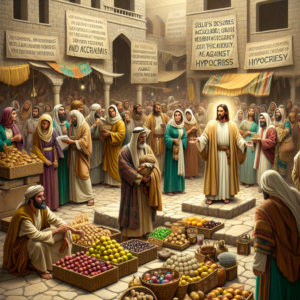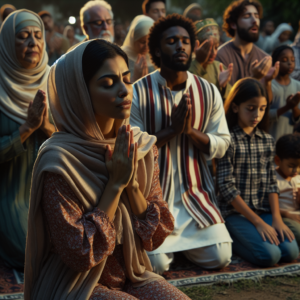Spiritual Devotional about Sacred Art
The Beauty and Power of Sacred Art in Spirituality
The expression of our faith and spirituality comes in a myriad of ways, one of them being through the tendrils of sacred art. Like the psalmist’s song and the sculptor’s craft, the beauty and the grandeur of religious art speaks to our soul and connects us to God in profound ways.
The Biblical Significance of Sacred Art
The Holy Scriptures, in Exodus 31:1-5, tells us about Bezalel, a man filled with the spirit of God, with skill, intelligence, and knowledge in all kinds of crafts. God Himself gave Bezalel the ability to make artistic designs— an explicit reference to the divine approval of the use of art in expressing spirituality.
“In the hearts of all who are skillful I have put skill.” – Exodus 31:6
This remarkable revelation demonstrates that our artistic talents and skills are indeed a gift from above. They are to be used for the glory of the Creator – a visual doxology, praising His name through colors, forms, and design.
The Language of Sacred Art
Sacred art doesn’t simply speak, indeed, it sings of the Almighty’s grandeur. It tells stories of faith and devotion. With its intricate patterns and exquisite details, each piece whispers untold tales and echoes profound wisdom. Like an open gate to the divine, religious art invites us to marvel and meditate on the divine mysteries.
The Inspiration Derived from Sacred Art
When we allow ourselves to be “spoken” to by sacred art, we open our hearts to deep inspiration. It moves us, stirs us and speaks to the innermost recesses of the soul. It challenges us to perceive God’s whisper in every stroke and shade of color, leading us to a path of enlightenment and peace.
Sacred art, therefore, is not only meant to adorn the walls of our churches but also our very lives. It is a manifestation of God’s divine beauty, a tool to deepen our faith, and a way to connect us more fully to the divine. Let us, therefore, engage in it, appreciate it and take inspiration from it to live an empowered spiritual life.
Embrace the Art, Connect with the Divine
So, let us embrace sacred art—not simply as a form of aesthetic enjoyment—but as an innovative spiritual practice. As we reflect on the rich symbolism and the sublime representations of these holy artworks, may we open our lives to the immeasurable love and grace of God.
Be moved, be inspired, dear child of God. Let the beauty of sacred art drive you closer to the heart of your Creator.
Explore and dig up answers yourself with our BGodInspired Bible Tools! Be careful – each interaction is like a new treasure hunt… you can get lost for hours 🙂
Q&A about Sacred Art
Q: What is meant by “Sacred Art”?
A: Sacred Art refers to any form of visual art that is used in worship or reverence of a divine power, typically centered on a religious or spiritual context. This includes paintings, sculptures, drawings, and other artistic expressions created with a religious or inspirational purpose.
Q: Can Sacred Art be found in all religions?
A: Yes, Sacred Art can be found across various religions and spiritual practices, however its characteristics, purposes, and forms greatly differ. For example, in Christianity, Jesus Christ, Mother Mary and saints are often depicted while in Buddhism, different manifestations of Buddha are the subject of the art.
Q: How old is the concept of Sacred Art?
A: The concept of Sacred Art can be traced back to the earliest civilizations. Even in prehistoric times, humans created art that depicted spiritual or religious themes, elements, symbols or deities.
Q: What is the function of Sacred Art in religious practice?
A: Sacred Art often serves multiple purposes in religious practice. It helps believers connect with the divine, serves as an aid in prayer or meditation, it may narrate religious stories or events and can be a representation of religious beliefs and principles.
Q: Can Sacred Art be used outside of religious buildings?
A: Yes, Sacred Art is used in a variety of contexts, not just religious buildings. It can be found in homes, public places, galleries and museums. The usage is not limited by location, but is more focused on the spiritual or religious significance it holds.
Q: How can one distinguish Sacred Art from other types of art?
A: Sacred Art can be distinguished by its themes, subjects, and contexts. It frequently depicts deities, religious figures, and spiritual themes. Furthermore, it is often accompanied by particular iconographies or symbols associated with a specific religion or spiritual practice.
Q: Has Sacred Art evolved over the years?
A: Yes, like all forms of art, Sacred Art too has evolved over centuries. Historical and socio-cultural changes have influenced the methods, styles, and themes of the Sacred Art in different eras. However, its core principle, the expression of spiritual or religious devotion, remains constant.
Q: What are some examples of Sacred Art?
A: There are countless examples of Sacred Art across different religions, such as the Sistine Chapel ceiling painted by Michelangelo, the Buddha statues of Sri Lanka, stained glass art in Gothic Cathedrals, or intricately designed Islamic calligraphy in mosques.



